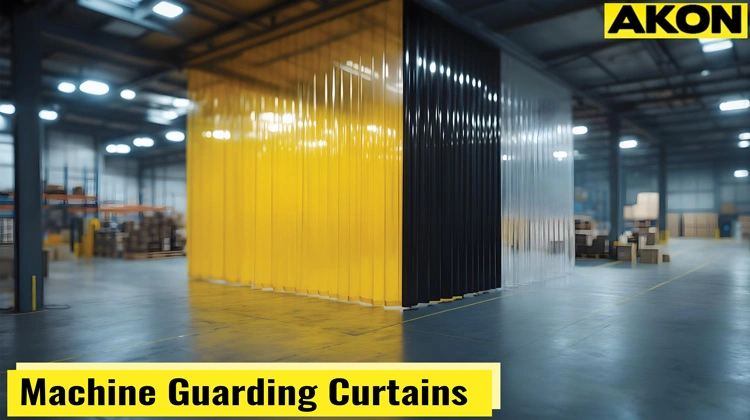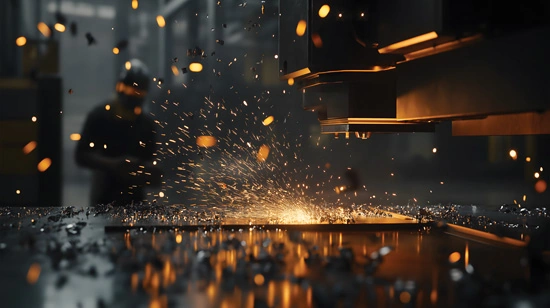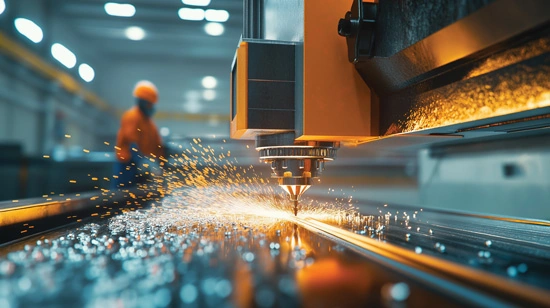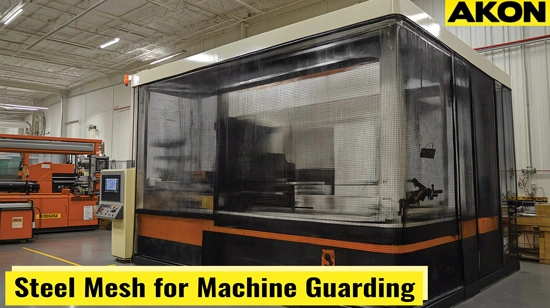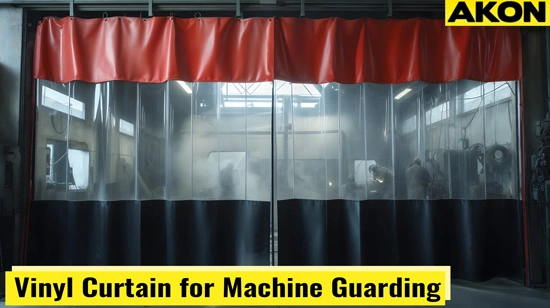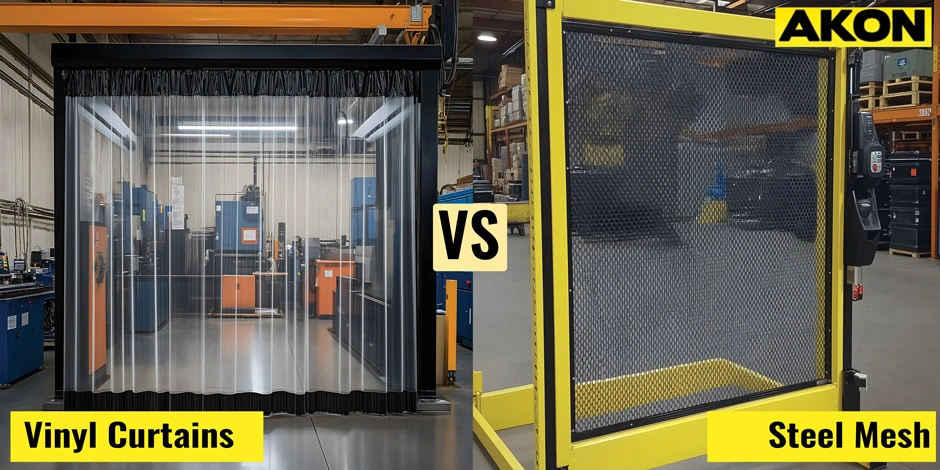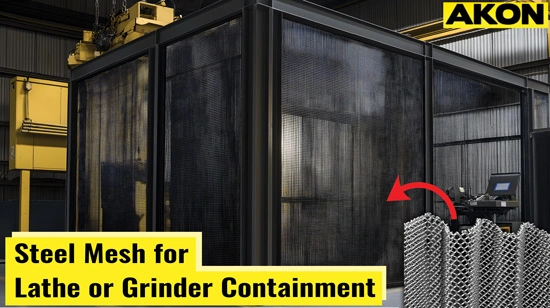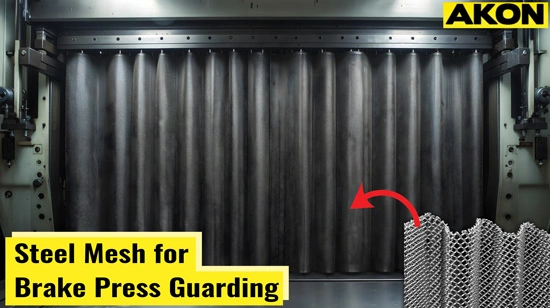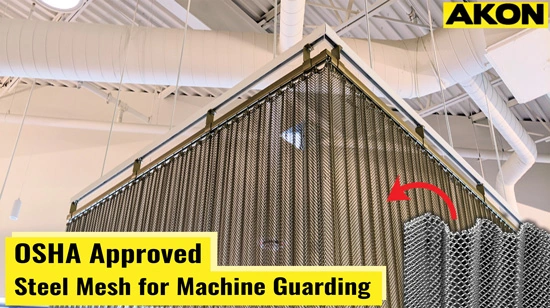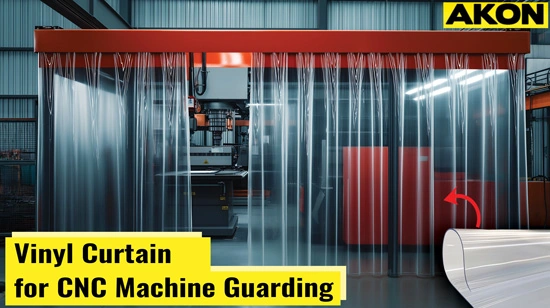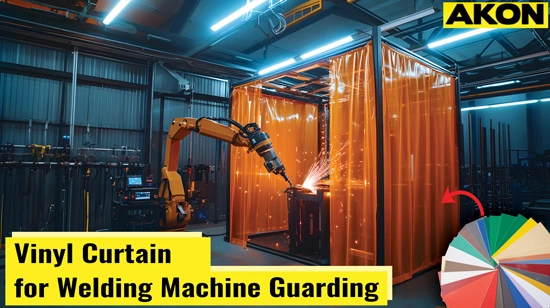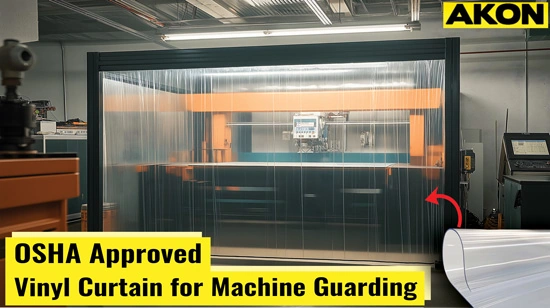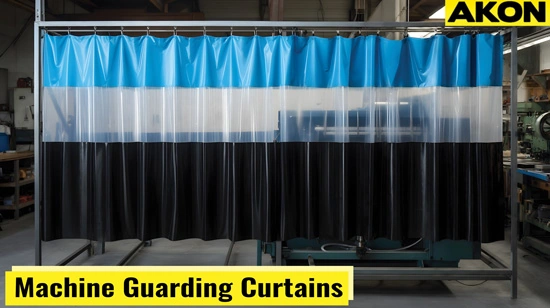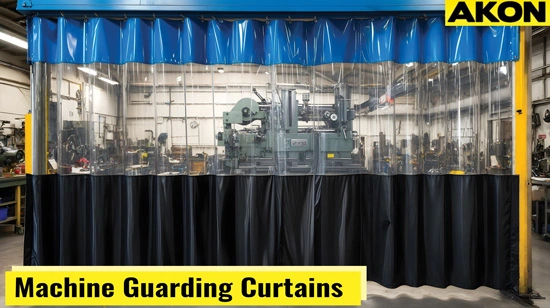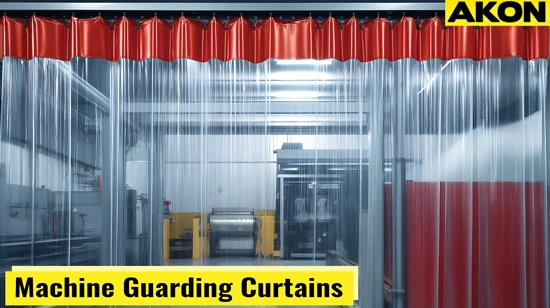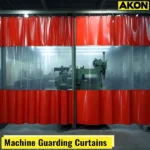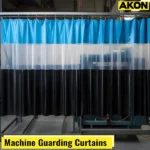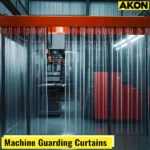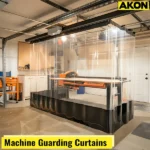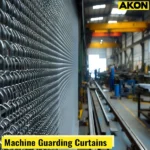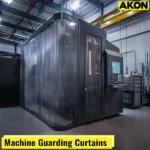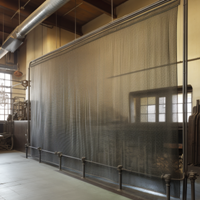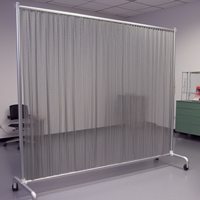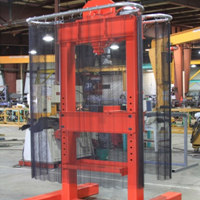Machine Guarding Curtains
In manufacturing facilities and machine shops, safeguarding workers from flying debris and projectiles is crucial. Machines such as CNC lathes, grinders, and other metal machining equipment frequently produce hazardous debris, posing significant risks. The solution lies in the use of specialized machine guarding curtains for projectiles—robust barriers designed to shield employees from injury and comply with OSHA safety standards.
Understanding Projectile Risks in Manufacturing
Your Operators Are At Risk
Machines in manufacturing environments generate high-speed projectiles, including metal chips, broken tool bits, grinding sparks, and other hazardous debris. Workers operating or near these machines face serious risks without proper protection. Understanding these risks and the appropriate protective measures ensures a safer working environment.
Why Use Machine Guarding Curtains?
Machine guarding curtains, particularly projectile containment curtains, are engineered specifically to intercept and contain flying debris. They provide a flexible yet strong barrier that protects workers without compromising visibility or accessibility. Below, we delve deeper into the distinct types and materials available, their effectiveness, and how they help ensure compliance with OSHA regulations.
Types of Machine Guarding Curtains for Projectiles
Steel Mesh | Machine Guarding Curtains
When strength and durability are paramount, steel machine guarding curtains are ideal. Often crafted from heavy-duty steel mesh, these curtains offer superior protection, especially in environments with intense projectile activity. Their robust construction makes them suitable for stopping larger, sharper, or heavier projectiles effectively.
Vinyl | Projectile Resistant Safety Curtains
Vinyl-based curtains, typically composed of high-strength 18oz vinyl, provide excellent flexibility and ease of use. While lighter and easier to maneuver compared to steel, these curtains are still incredibly effective in containing smaller to medium-sized debris. Their versatility and ease of customization make them popular for various applications, including shielding CNC operators and enclosing lathe or grinder operations.
Curtains to Stop Flying Debris: What Makes Them Effective?
Material Strength
High-tensile steel mesh or heavy-duty 18oz vinyl ensures maximum durability.
Transparency
Clear vinyl or mesh designs allow operators to maintain visibility while ensuring safety.
Customizability
Tailored to fit equipment and workstations precisely, maximizing protection and ease of use.
Which Material Is Right For You?
Vinyl Vs. Steel Mesh
| Criteria | Vinyl Curtains | Steel Curtains |
|---|---|---|
| Debris Type & Size | Ideal for small to medium debris (metal chips, light sparks) | Best for large, sharp, or heavy projectiles |
| Frequency & Speed of Projectiles | Suitable for moderate impact scenarios | Excellent for high-velocity and frequent projectile exposure |
| Durability & Strength | Flexible and maneuverable, less resistant to cuts | Highly durable, resistant to piercing and cutting |
| Visibility | Clear or mesh options for full operator visibility | Limited visibility depending on mesh size/design |
| Compliance with OSHA Standards | Compliant when properly rated and installed | Often preferred for stringent safety compliance needs |
| Cost & Deployment | More economical, quick to install | Higher upfront cost, more permanent |
Steel Mesh
Steel Mesh Curtain Benefits
Better Airflow
Steel mesh curtains provide for greater ventilation and airflow, ensuring that the air in the workspace is properly circulated. By limiting the buildup of heat or odors, this aids in maintaining a cozy and beneficial working environment.
Quick Operation
Steel mesh curtains can be made with a variety of opening methods, including sliding or rolling systems, making them simple to use and flexible. This maintains the required safety and security while enabling simple access to particular regions.
Many Applications
Steel mesh safety curtains can be used for a variety of purposes other than safety barriers. They can be used to divide up areas while retaining visibility and safety in industrial settings by acting as partitions, dividers, or enclosures.
Meet Regulations
Steel mesh curtains are created and constructed in accordance with industry standards and safety guidelines. Businesses may assure compliance and mitigate any safety concerns by utilizing these curtains.
Applications
Containment Curtains for Lathe or Grinder Projectiles
Lathes and grinders produce high-speed projectiles like metal chips and grinding sparks. Steel mesh safety curtains are especially beneficial here.
Their design allows them to absorb and deflect debris effectively, minimizing risk. Custom safety curtains for these applications ensure full coverage, providing robust containment tailored precisely to your specific machining needs.
Brake Press Guarding: Why Steel Mesh Works Well
Steel mesh is perfect for protecting workers around brake presses because it stops flying metal pieces while letting people see through it. Unlike solid barriers, mesh allows workers to watch what they're doing while staying safe.
The steel is strong enough to block dangerous bits but doesn't get in the way of doing the job properly. The flexibility of the mesh helps absorb impacts when something hits it.
OSHA Approved for Flying Projectiles
Steel mesh guards keep workers safe around machines like brake presses. OSHA approves these guards because they meet important safety rules (ANSI B11.19-2003). The wire curtains stop flying pieces from hitting people if something breaks or comes loose from the machine.
The mesh design lets workers see what they're doing while staying protected. They contain debris inside the work area and prevent injuries. Steel mesh is practical, see-through, and meets the safety standards that workplaces must follow by law.
Vinyl
Vinyl Curtains Benefits
Easy Install
Vinyl curtains feature built-in grommets at the top, enabling quick and effortless installation with or without tracks, making them an ideal low-maintenance guarding solution for machinery.
Inexpensive
At approximately one-third the cost of rigid walls or panel systems while being easily storable when not in use, vinyl curtains offer an economical and space-efficient option for machine guarding.
Separate Workers
The versatility of vinyl curtain walls makes them perfect for safely separating workers from machinery during welding, washing, packaging, and numerous other industrial operations.
Control Noise
The thick PVC composition of vinyl curtains significantly reduces noise transmission from machinery, creating a more comfortable and less fatiguing work environment for operators.
Applications
CNC Machine Cover
CNC operators require barriers that provide visibility, accessibility, and superior protection. Vinyl-based projectile containment curtains often excel here due to their transparency, flexibility, and capability to absorb impact.
They allow CNC operators clear line-of-sight to operations, facilitating precise control while ensuring safety from flying debris.
Welding Machine Guarding
Welders require barriers that provide UV protection, fire safety, and comprehensive coverage. Vinyl-based welding curtains often excel here due to their fire retardancy, UV-blocking capabilities, and customizable dimensions.
They allow welding operations to be conducted safely in any environment, effectively containing hazardous rays while adapting to spaces that rigid screens cannot accommodate.
OSHA Approved Guarding for Flying Projectiles
OSHA has stringent guidelines concerning workplace safety, specifically machine guarding requirements under OSHA Standard 1910.212.
Machine guarding curtains for projectiles must effectively contain hazards, protect workers, and be durable enough to withstand regular impact. Using OSHA-approved guarding solutions ensures compliance, reduces injury risks, and potentially lowers insurance premiums and workplace incidents.
How to Protect Workers from Flying Machine Parts
Protecting workers from flying machine parts involves a multi-faceted approach:
- Assessment and Planning: Evaluate the types of machines and potential projectile risks.
- Selecting Proper Barriers: Choose the most suitable curtain—vinyl vs. steel—based on your specific needs.
- Proper Installation: Curtains must be installed strategically around machines to contain and deflect projectiles effectively.
- Regular Inspection and Maintenance: Ensure curtains remain effective by conducting routine checks and maintenance.
Impact-Resistant Curtains
Impact-resistant curtains offer a balance between robust protection and operational convenience. These curtains are engineered to withstand high-velocity impacts, making them ideal for environments like CNC machining centers or metal machining operations.
They serve as an effective solution to safeguard workers from flying debris without hindering operational visibility or accessibility.
Custom Safety Curtains for Metal Machining: Tailored Protection
Customization of safety curtains is key to maximizing effectiveness. Machine guarding curtains can be custom-sized, shaped, and configured to match the unique demands of different manufacturing setups.
Such tailored solutions guarantee comprehensive protection, minimizing the chances of projectiles escaping the containment area.
Frequently Asked Questions About Machine Guarding
Frequently Asked Questions
What is machine guarding?
Machine guarding is the use of barriers or devices to protect operators and other employees from hazards created by moving machinery parts, flying chips, sparks, or rotating components.
Why is machine guarding necessary?
It prevents injuries such as crushed fingers or hands, amputations, burns, and blindness by providing a physical barrier between the worker and hazardous machine parts.
What types of machine guards are available?
Common types include fixed guards, interlocked guards, adjustable guards, and self-adjusting guards, each suited for different applications and levels of access needed.
Are machine guards required by law?
Yes. OSHA Standard 1910.212 requires that any machine part, function, or process that may cause injury must be guarded to ensure worker safety.
Can machine guards be customized?
Absolutely. Custom guards can be designed to fit specific machines, applications, and workspace layouts, while maintaining compliance and safety standards.
How do I maintain machine guarding systems?
Regular inspections, cleaning, and checking for damage or wear are essential. Guards should always be securely in place and functional before operating machinery.
Conclusion
When selecting the best machine guarding curtain, consider your specific application. Choose steel mesh if you need maximum strength for high-impact environments where sharp or heavy projectiles are a risk. Opt for vinyl with clear panels if visibility and moderate protection are your priorities, especially in areas with lower-speed debris. For applications that need both visibility and strength, a hybrid curtain may be the best solution. If you're unsure which option fits your needs, our team is here to help you evaluate your environment and recommend the most effective safety curtain for your operation. Take proactive measures today and safeguard your workforce with reliable and effective machine guarding curtains for projectiles.

